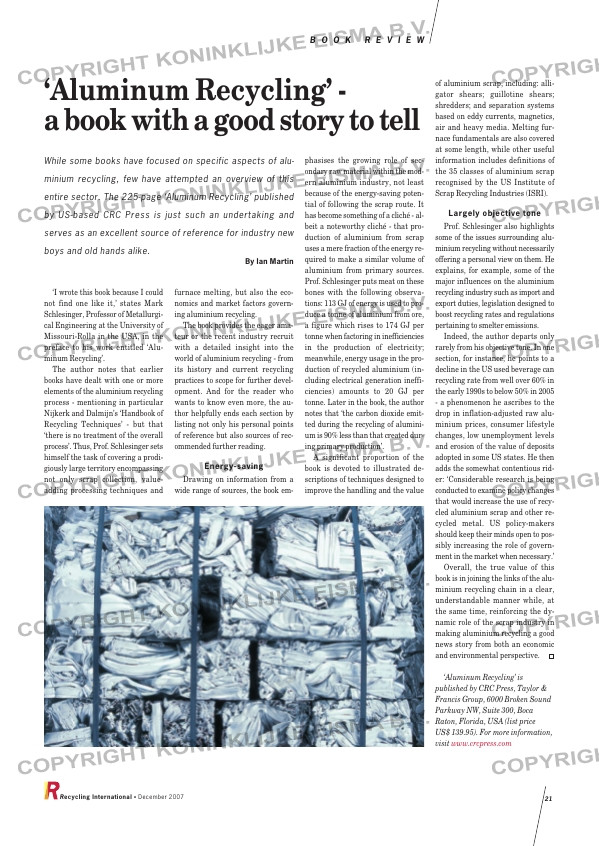Page 21 from: December 2007

‘I wrote this book because I could
not find one like it,’ states Mark
Schlesinger, Professor of Metallurgi-
cal Engineering at the University of
Missouri-Rolla in the USA, in the
preface to his work entitled ‘Alu-
minum Recycling’.
The author notes that earlier
books have dealt with one or more
elements of the aluminium recycling
process – mentioning in particular
Nijkerk and Dalmijn’s ‘Handbook of
Recycling Techniques’ – but that
‘there is no treatment of the overall
process’. Thus, Prof. Schlesinger sets
himself the task of covering a prodi-
giously large territory encompassing
not only scrap collection, value-
adding processing techniques and
furnace melting, but also the eco-
nomics and market factors govern-
ing aluminium recycling.
The book provides the eager ama-
teur or the recent industry recruit
with a detailed insight into the
world of aluminium recycling – from
its history and current recycling
practices to scope for further devel-
opment. And for the reader who
wants to know even more, the au-
thor helpfully ends each section by
listing not only his personal points
of reference but also sources of rec-
ommended further reading.
Energy-saving
Drawing on information from a
wide range of sources, the book em-
phasises the growing role of sec-
ondary raw material within the mod-
ern aluminium industry, not least
because of the energy-saving poten-
tial of following the scrap route. It
has become something of a cliché – al-
beit a noteworthy cliché – that pro-
duction of aluminium from scrap
uses a mere fraction of the energy re-
quired to make a similar volume of
aluminium from primary sources.
Prof. Schlesinger puts meat on these
bones with the following observa-
tions: 113 GJ of energy is used to pro-
duce a tonne of aluminium from ore,
a figure which rises to 174 GJ per
tonne when factoring in inefficiencies
in the production of electricity;
meanwhile, energy usage in the pro-
duction of recycled aluminium (in-
cluding electrical generation ineffi-
ciencies) amounts to 20 GJ per
tonne. Later in the book, the author
notes that ‘the carbon dioxide emit-
ted during the recycling of alumini-
um is 90% less than that created dur-
ing primary production’.
A significant proportion of the
book is devoted to illustrated de-
scriptions of techniques designed to
improve the handling and the value
of aluminium scrap, including: alli-
gator shears; guillotine shears;
shredders; and separation systems
based on eddy currents, magnetics,
air and heavy media. Melting fur-
nace fundamentals are also covered
at some length, while other useful
information includes definitions of
the 35 classes of aluminium scrap
recognised by the US Institute of
Scrap Recycling Industries (ISRI).
Largely objective tone
Prof. Schlesinger also highlights
some of the issues surrounding alu-
minium recycling without necessarily
offering a personal view on them. He
explains, for example, some of the
major influences on the aluminium
recycling industry such as import and
export duties, legislation designed to
boost recycling rates and regulations
pertaining to smelter emissions.
Indeed, the author departs only
rarely from his objective tone. In one
section, for instance, he points to a
decline in the US used beverage can
recycling rate from well over 60% in
the early 1990s to below 50% in 2005
– a phenomenon he ascribes to the
drop in inflation-adjusted raw alu-
minium prices, consumer lifestyle
changes, low unemployment levels
and erosion of the value of deposits
adopted in some US states. He then
adds the somewhat contentious rid-
er: ‘Considerable research is being
conducted to examine policy changes
that would increase the use of recy-
cled aluminium scrap and other re-
cycled metal. US policy-makers
should keep their minds open to pos-
sibly increasing the role of govern-
ment in the market when necessary.’
Overall, the true value of this
book is in joining the links of the alu-
minium recycling chain in a clear,
understandable manner while, at
the same time, reinforcing the dy-
namic role of the scrap industry in
making aluminium recycling a good
news story from both an economic
and environmental perspective.
‘Aluminum Recycling’ is
published by CRC Press, Taylor &
Francis Group, 6000 Broken Sound
Parkway NW, Suite 300, Boca
Raton, Florida, USA (list price
US$ 139.95). For more information,
visit www.crcpress.com
B O O K R E V I E W
Recycling International • December 2007 21
‘Aluminum Recycling’ –
a book with a good story to tell
While some books have focused on specific aspects of alu-
minium recycling, few have attempted an overview of this
entire sector. The 225-page ‘Aluminum Recycling’ published
by US-based CRC Press is just such an undertaking and
serves as an excellent source of reference for industry new
boys and old hands alike.
By Ian Martin
RI_013 Book review:Opmaak 1 06-12-2007 14:28 Pagina 21



